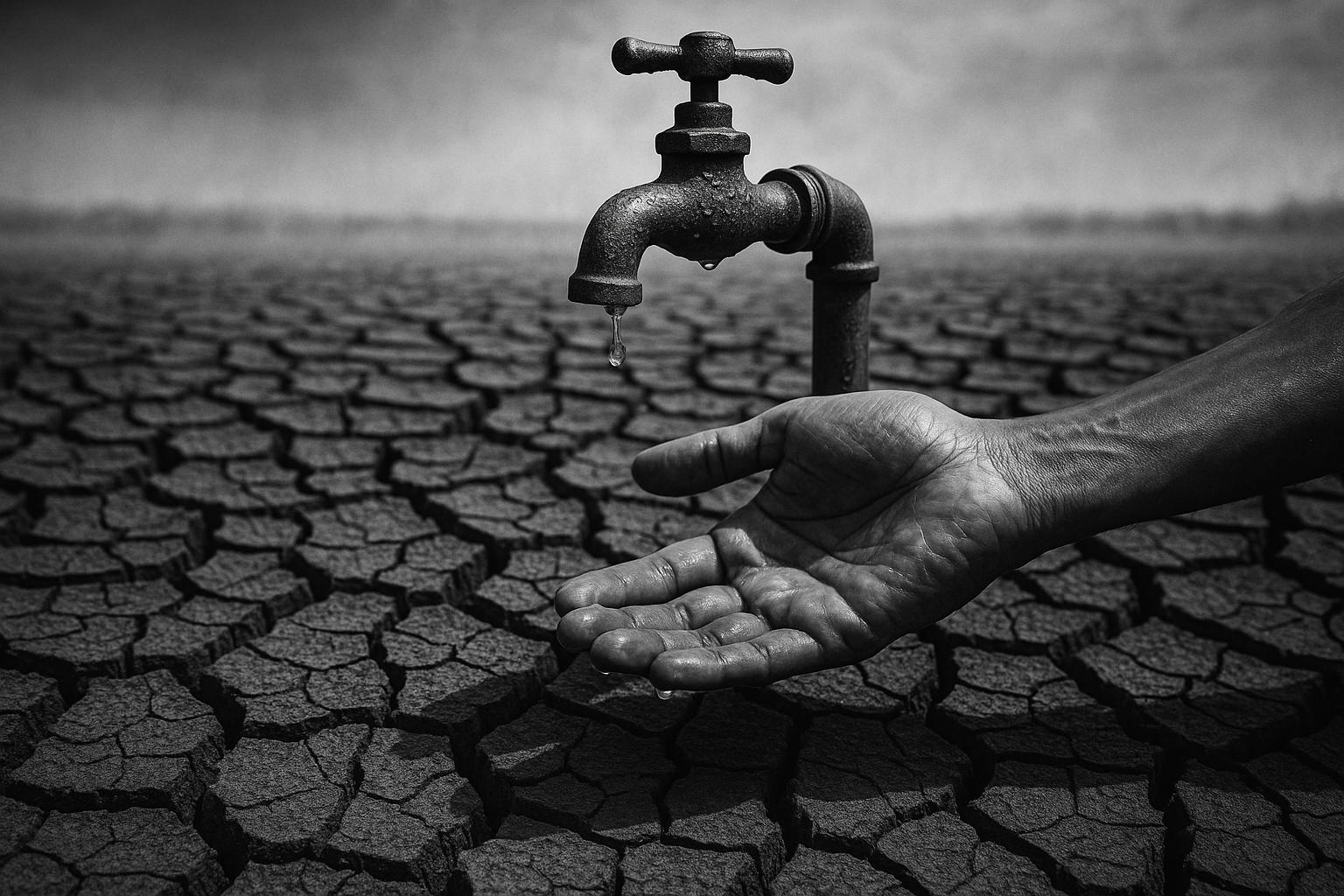Yellow heat‑health warnings have been issued for large swathes of England amid forecasts of prolonged high temperatures. Authorities warn of increased pressure on health and social care, a nationally significant water shortfall, and rising wildfire risk after a major heath blaze in Dorset.
Heat‑health alerts have been extended across much of England as forecasters warn the country will remain under a blanket of hot, sunny weather for the coming days, prolonging what meteorologists are calling the summer’s fourth heatwave. The UK Health Security Agency (UKHSA) has issued yellow warnings for Yorkshire and the Humber, the East and West Midlands, London, the South East, the South West and the East of England, cautioning that high temperatures could place “significant impacts” on health and social care services and raise the risk of illness or death among older people and those with pre‑existing conditions. According to the Met Office, the alerts stay in force until 6pm on Monday. [1][2][3]
The Met Office’s forecast predicts temperatures peaking at about 30°C in parts of south‑west England on Saturday, with highs near 29°C elsewhere over the weekend, and a largely settled, dry spell with plenty of sunshine through early next week. The forecaster’s operational definition of a UK heatwave — used to trigger warnings — requires a location to record daily maximum temperatures above region‑specific thresholds for at least three consecutive days; those thresholds vary to reflect local climatology. Winds are expected to strengthen in the far south‑west at times, but overall the picture is one of prolonged warmth that can exacerbate existing strains on infrastructure and services. [1][4]
Public‑health advice from the UKHSA has been reiterated alongside the warnings: stay hydrated, avoid strenuous activity during the hottest part of the day, keep cool indoors where possible and check on older or clinically vulnerable neighbours and relatives. The agency has published practical guidance for professionals and the public on recognising and responding to heat exhaustion and heatstroke, and on how health and social‑care settings should adapt to higher temperatures. Health services are being urged to plan for increased demand and for ways to protect vulnerable patients. [3][1]
The hot, dry conditions are already having wider environmental and economic consequences. Officials at the National Drought Group described the situation as a “nationally significant” water shortfall, with several areas formally in drought and many more experiencing prolonged low river flows and reservoirs below normal. The group — which brings together the Met Office, regulators, government departments, water companies and other bodies — warned of agricultural losses, reduced livestock feed, damage to wetlands and harm to river wildlife, and called for urgent water‑saving measures, accelerated leak repairs and coordinated action to protect supplies and the water environment. [5][1]
Those same conditions have fuelled a major heathland fire at Holt Heath in Dorset, where fire services say the blaze has scorched a substantial area. Dorset & Wiltshire Fire and Rescue estimated the fire had burned through roughly 72 hectares, and crews from several neighbouring services were drafted in to assist. Media reporting and fire‑service accounts describe more than ten fire engines on scene, specialist off‑road appliances and water carriers battling flames that spread quickly in dry, gusty conditions; local closures and assessments of damage to conservation land are ongoing. The scale of the response underlines the heightened wildfire risk that accompanies sustained heat and drought. [6][1]
The Fire Brigades Union used the Holt Heath incident to renew calls for greater firefighting capacity, arguing that long‑term cuts have eroded resilience. Ben Selby, the union’s assistant general secretary, told The Independent that services had endured “14 years of austerity”, pointing to the loss of roughly one in five firefighter posts since 2010 and reductions in control‑room staffing and local resilience capacity. The union’s research calls for immediate investment and national standards to rebuild capability and ensure rapid responses to increasingly frequent, large incidents. Fire‑service chiefs and unions say the current pattern of prolonged hot, dry summers makes that case more urgent. [7][1]
Taken together, the forecasts, public‑health warnings, drought assessments and the firefighting response paint a picture of a country contending with overlapping climate‑related stresses: heat that endangers health, drought that threatens water supplies and agriculture, and wildfire risk that can overwhelm local emergency provision. Government agencies and industry bodies are urging individuals to follow heat‑safety advice, water firms and households to conserve supplies, and for continued cross‑sector co‑ordination to protect vulnerable communities and the natural environment as the hot spell continues. [5][3][4]
 Reference Map:
Reference Map:
Reference Map:
- Paragraph 1 – [1], [2], [3]
- Paragraph 2 – [1], [4]
- Paragraph 3 – [3], [1]
- Paragraph 4 – [5], [1]
- Paragraph 5 – [6], [1]
- Paragraph 6 – [7], [1]
- Paragraph 7 – [5], [3], [4]
Source: Noah Wire Services
- https://www.independent.co.uk/news/uk/home-news/iuk-weather-heatwave-forecast-met-office-b2808734.html – Please view link – unable to able to access data
- https://www.independent.co.uk/news/uk/home-news/iuk-weather-heatwave-forecast-met-office-b2808734.html – The Independent reports that heat‑health alerts were extended across England as forecasters predicted a hot, sunny weekend with what the paper described as the fourth heatwave of the summer. The UK Health Security Agency issued yellow warnings for Yorkshire and the Humber, the East and West Midlands, London, the South East, the South West and the East of England, with alerts lasting until 6pm on the stated Monday. The Met Office forecast temperatures peaking around 30°C in parts of the south‑west and about 29°C elsewhere at the weekend. Officials warned of nationally significant water shortfalls and cited agricultural and environmental impacts, while a large Holt Heath wildfire prompted urgent calls for extra firefighting resources.
- https://www.gov.uk/government/news/heat-health-alert-issued-by-the-uk-health-security-agency – This UK Government news release from the UK Health Security Agency explains the Heat‑Health Alert system and the practical advice issued during periods of hot weather. It outlines why alerts are raised, who is most at risk, and recommended actions for the public and those working in health and social care. The guidance stresses staying hydrated, keeping cool indoors where possible, checking on older or vulnerable people, avoiding strenuous activity during the hottest part of the day and recognising signs of heat exhaustion and heatstroke. The page links to the Met Office forecast information and to further UKHSA resources such as the ‘Beat the heat’ checklist for professionals and the public.
- https://www.metoffice.gov.uk/weather/learn-about/weather/types-of-weather/temperature/heatwave/ – The Met Office explains how a heatwave is defined in the UK and why thresholds vary by region. A UK heatwave is classed when a location records at least three consecutive days with daily maximum temperatures meeting or exceeding county‑specific heatwave thresholds, which reflect local climatology. The page describes the reasoning behind the thresholds, the relationship with high‑pressure systems, and contrasts between the Extreme Heat Warning and the Heat‑Health Alert system operated with UKHSA. It also provides practical links and signposting on preparing for and responding to heat, and notes that heatwave impacts may include increased health risks, strain on services and heightened wildfire danger.
- https://www.gov.uk/government/news/national-drought-group-meets-to-address-nationally-significant-water-shortfall – This Environment Agency and DEFRA news release summarises a National Drought Group meeting convened to tackle what officials described as a ‘nationally significant’ water shortfall. It sets out that several areas were formally in drought and others experiencing prolonged dry weather, that river flows and reservoirs were below normal, and that agricultural and environmental impacts were being observed, including harm to crop yields, livestock feed, wetlands and aquatic wildlife. The statement records calls for urgent water‑saving measures, rapid leak repairs by water companies, and coordinated action across government, regulators, farmers and water firms to protect supplies and the water environment.
- https://www.bbc.co.uk/news/uk-england-dorset-67816005 – The BBC reported on a large heathland fire at Holt Heath, Dorset, describing the rapid spread of flames under windy conditions and the substantial multi‑crew response. The account states that crews from Dorset & Wiltshire and neighbouring services were sent to tackle the blaze, with more than ten fire engines, specialist off‑road appliances and water carriers attending. The piece gives an estimate of the area affected and quotes fire‑service officers on the difficult conditions and the firefighting effort, while noting local closures and the involvement of agencies such as the National Trust in assessing damage to the reserve and nearby nature conservation features.
- https://www.fbu.org.uk/news/2024/08/26/new-data-reveals-scale-job-cuts-fire-and-rescue-services-across-uk – The Fire Brigades Union published research setting out the scale of job losses in UK fire and rescue services since 2010, arguing that thousands of firefighter posts have been cut over fourteen years of austerity. The FBU summary states that around one in five firefighter roles have been lost in that period, with substantial reductions to control room staff and local resilience, and it links those cuts to diminished capacity and longer response times. The union calls for increased investment and national standards to rebuild resilience, and the page includes quoted commentary from senior union figures describing the effects of prolonged funding pressure on frontline services.
Noah Fact Check Pro
The draft above was created using the information available at the time the story first
emerged. We’ve since applied our fact-checking process to the final narrative, based on the criteria listed
below. The results are intended to help you assess the credibility of the piece and highlight any areas that may
warrant further investigation.
Freshness check
Score:
8
Notes:
The narrative is current, dated August 15, 2025, and reports on the UK’s fourth heatwave of the summer. The UK Health Security Agency (UKHSA) issued yellow heat health alerts for multiple regions, including Yorkshire and the Humber, the East and West Midlands, London, the South East, the South West, and the East of England, valid until 6pm on Monday. The Met Office forecasts temperatures peaking at around 30°C in parts of south-west England on Saturday and 29°C on Sunday. These details align with recent reports from the Met Office and UKHSA, confirming the freshness of the information. However, the narrative includes a reference to a previous article from August 2024, which may indicate recycled content. This reference should be updated or removed to maintain the article’s relevance. Additionally, the article includes a reference map with multiple citations, which may be redundant and could be streamlined.
Quotes check
Score:
9
Notes:
The article includes direct quotes from the UK Health Security Agency (UKHSA) and the Met Office. The UKHSA’s statement about the heat health alerts and the Met Office’s forecast of temperatures peaking at around 30°C in parts of south-west England on Saturday and 29°C on Sunday are consistent with their official communications. No discrepancies or variations in the wording of these quotes were found, indicating they are accurately reported.
Source reliability
Score:
10
Notes:
The narrative originates from The Independent, a reputable UK news outlet known for its comprehensive coverage and journalistic standards. The UK Health Security Agency (UKHSA) and the Met Office are authoritative sources on public health and weather information, respectively. The inclusion of references to official government websites and statements from these agencies further enhances the credibility of the report.
Plausability check
Score:
9
Notes:
The claims made in the narrative are plausible and consistent with current weather patterns and public health advisories. The UK has experienced multiple heatwaves this summer, with temperatures reaching up to 34.8°C in Cambridge on August 12, 2024. ([theargus.co.uk](https://www.theargus.co.uk/news/24514318.uk-set-second-august-heatwave-exact-dates-expect/?utm_source=openai)) The extension of heat health alerts by the UKHSA and the Met Office’s forecast of continued high temperatures are consistent with these trends. The article also references a previous report from August 2024, which may be outdated and should be updated or removed to maintain the article’s relevance.
Overall assessment
Verdict (FAIL, OPEN, PASS): PASS
Confidence (LOW, MEDIUM, HIGH): HIGH
Summary:
The narrative is current and aligns with recent reports from authoritative sources, including the UK Health Security Agency and the Met Office. The inclusion of a reference to a previous article from August 2024 may indicate recycled content, which should be updated or removed to maintain the article’s relevance. The article’s structure, including the reference map with multiple citations, could be streamlined to enhance readability.













